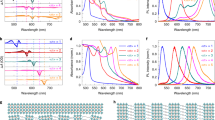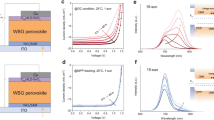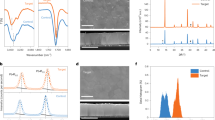Abstract
Organolead trihalide perovskite materials have been successfully used as light absorbers in efficient photovoltaic cells. Two different cell structures, based on mesoscopic metal oxides and planar heterojunctions have already demonstrated very impressive advances in performance. Here, we report a bilayer architecture comprising the key features of mesoscopic and planar structures obtained by a fully solution-based process. We used CH3NH3 Pb(I1 − xBrx)3 (x = 0.1–0.15) as the absorbing layer and poly(triarylamine) as a hole-transporting material. The use of a mixed solvent of γ-butyrolactone and dimethylsulphoxide (DMSO) followed by toluene drop-casting leads to extremely uniform and dense perovskite layers via a CH3NH3I–PbI2–DMSO intermediate phase, and enables the fabrication of remarkably improved solar cells with a certified power-conversion efficiency of 16.2% and no hysteresis. These results provide important progress towards the understanding of the role of solution-processing in the realization of low-cost and highly efficient perovskite solar cells.
This is a preview of subscription content, access via your institution
Access options
Subscribe to this journal
Receive 12 print issues and online access
$259.00 per year
only $21.58 per issue
Buy this article
- Purchase on Springer Link
- Instant access to full article PDF
Prices may be subject to local taxes which are calculated during checkout





Similar content being viewed by others
References
Yella, A. Porphyrin-sensitized solar cells with cobalt (II/III)–based redox electrolyte exceed 12 percent efficiency. Science 334, 629–634 (2011).
Kramer, l. J. & Sargent, E. H. The architecture of colloidal quantum dot solar cells: Materials to devices. Chem. Rev. 114, 863–882 (2014).
Im, S. H. et al. All solid state multiply layered PbS colloidal quantum-dot-sensitized photovoltaic cells. Energy Environ. Sci. 4, 4181–4186 (2011).
Li, G., Zhu, R. & Yang, Y. Polymer solar cells. Nature Photon. 6, 153–161 (2012).
Congreve, D. N. et al. External quantum efficiency above 100% in a singlet-exciton-fission-based organic photovoltaic cell. Science 340, 334–337 (2013).
Chang, J. A. et al. High-performance nanostructured inorganic–organic heterojunction solar cells. Nano Lett. 10, 2609–2612 (2010).
Chang, J. A. et al. Panchromatic photon-harvesting by hole-conducting materials in inorganic–organic heterojunction sensitized-solar cell through the formation of nanostructured electron channels. Nano Lett. 12, 1863–1867 (2012).
Lee, M. M. et al. Efficient hybrid solar cells based on meso-superstructured organometal halide perovskites. Science 338, 643–647 (2012).
Kim, H-S. et al. Lead iodide perovskite sensitized all-solid-state submicron thin film mesoscopic solar cell with efficiency exceeding 9%. Sci. Rep. 2, 591 (2012).
Heo, J. H. et al. Efficient inorganic–organic hybrid heterojunction solar cells containing perovskite compound and polymeric hole conductors. Nature Photon. 7, 486–491 (2013).
Burschka, J. et al. Sequential deposition as a route to high-performance perovskite-sensitized solar cells. Nature 499, 316–319 (2013).
Liu, M., Johnston, M. B. & Snaith, H. J. Efficient planar heterojunction perovskite solar cells by vapour deposition. Nature 501, 395–398 (2013).
Noh, J. H., Im, S. H., Heo, J. H., Mandal, T. N. & Seok, S. I. Chemical management for colorful, efficient, and stable inorganic–organic hybrid nanostructured solar cells. Nano Lett. 13, 1764–1769 (2013).
Malinkiewicz, O. et al. Perovskite solar cells employing organic charge-transport layers. Nature Photon. 6, 128–132 (2014).
Waleed, W. A. & Etgar, L. Depleted hole conductor-free lead halide iodide heterojunction solar cells. Energy Environ. Sci. 6, 3249–3253 (2013).
You, J. et al. Low-temperature solution-processed perovskite solar cells with high efficiency and flexibility. ACS Nano 8, 1674–1680 (2014).
Stranks, S. D. et al. Electron–hole diffusion lengths exceeding 1 micrometer in an organometal trihalide perovskite absorber. Science 342, 341–344 (2013).
Xing, G. et al. Long-range balanced electron- and hole-transport lengths in organic–inorganic CH3NH3PbI3 . Science 342, 344–347 (2013).
Jeng, J-U. et al. CH3NH3PbI3 perovskite/fullerene planar-heterojunction hybrid solar cells. Adv. Mater. 25, 3727–3732 (2013).
Eperon, G. E., Burlakov, V. M., Docampo, P., Goriely, A. & Snaith, H. J. Morphological control for high performance, solution-processed planar heterojunction perovskite solar cells. Adv. Funct. Mater. 24, 151–157 (2014).
Beckmann, P. A. A review of polytypism in lead iodide. Cryst. Res. Technol. 45, 455–460 (2010).
Miyamae, H. et al. The crystal structure of lead(II) iodide-dimethylsulphoxide(1/2), PbI2(DMSO)2 . Chem. Lett. 6, 663–664 (1980).
Herman, M. et al. Optimal I–V curve scan time of solar cells and modules in light of irradiance level. Int. J. Photoenergy 2012, 151452 (2012)
Koide, N. & Han, I. Measuring methods of cell performance of dye-sensitized solar cells. Rev. Sci. Instrum. 75, 2828–2831 (2004).
Acknowledgements
This work was supported by the Global Research Laboratory (GRL) Program, the Global Frontier R&D Program of the Center for Multiscale Energy System funded by the National Research Foundation in Korea, and by a grant from the KRICT 2020 Program for Future Technology of the Korea Research Institute of Chemical Technology (KRICT), Republic of Korea.
Author information
Authors and Affiliations
Contributions
N.J.J., J.H.N. and S.I.S. conceived the experiments, data analysis and interpretation. N.J.J., Y.C.K., W.S.Y., S.R. and J.H.N. performed the fabrication of devices, device performance measurements and characterization. N.J.J., S.R., Y.C.K. and W.S.Y. carried out the synthesis of materials for perovskites and S.I.S prepared TiO2 particles and pastes. The manuscript was written by S.I.S., J.H.N. and N.J.J. The project was planned, directed and supervised by S.I.S. All authors discussed the results and commented on the manuscript.
Corresponding author
Ethics declarations
Competing interests
The authors declare no competing financial interests.
Supplementary information
Supplementary Information
Supplementary file (PDF 912 kb)
Rights and permissions
About this article
Cite this article
Jeon, N., Noh, J., Kim, Y. et al. Solvent engineering for high-performance inorganic–organic hybrid perovskite solar cells. Nature Mater 13, 897–903 (2014). https://doi.org/10.1038/nmat4014
Received:
Accepted:
Published:
Issue Date:
DOI: https://doi.org/10.1038/nmat4014



